....
WHY?:Air to fuel is fundamental to internal combustion engines and so as you slide down the slippery slope of modding yelling "Yippee!", sooner or later you will feel an uncontrollable urge to replace your oem air intake. What has possibly kept you from doing so earlier is that you might not have wanted to frighten away your VW warranty when your dealer's workshop opens your bonnet and is alarmed to think a python has sneaked into your engine bay as most aftermarket air intakes are of the high-flow tubular variety.
Aftermarket air intakes are so often criticised for being poor value-for-money. Indeed, when used on a standard car without any other performance modifications they are not cost effective at all. The oem air intake is adequate but doesn't seek to deliver especially cold air because standard cars are designed to also be sold in climates where cold starting and running may even be an issue. It's that same old consideration of factory cars needing to compromise in order to more efficiently appeal to their biggest mass market - There's nothing wrong with that but it's why some of us think we can improve our cars by modding, and the truth is that we succeed.
And so the objective part of the question of 'why', is that having an aftermarket air intake will usually improve both the flow and temperature of air and hence improve whole performance, though it must be said that the stock air intake system is very good and takes air from the most efficient inlet position. The subjective part is as complex as most of the human individuals who are making the choice, but tend to be based on the following considerations (not in order of importance):-
- Performance
- Standard of manufacture
- Ease of maintenance
- Sound
- Appearance aka 'Eye-Candy'
- Price
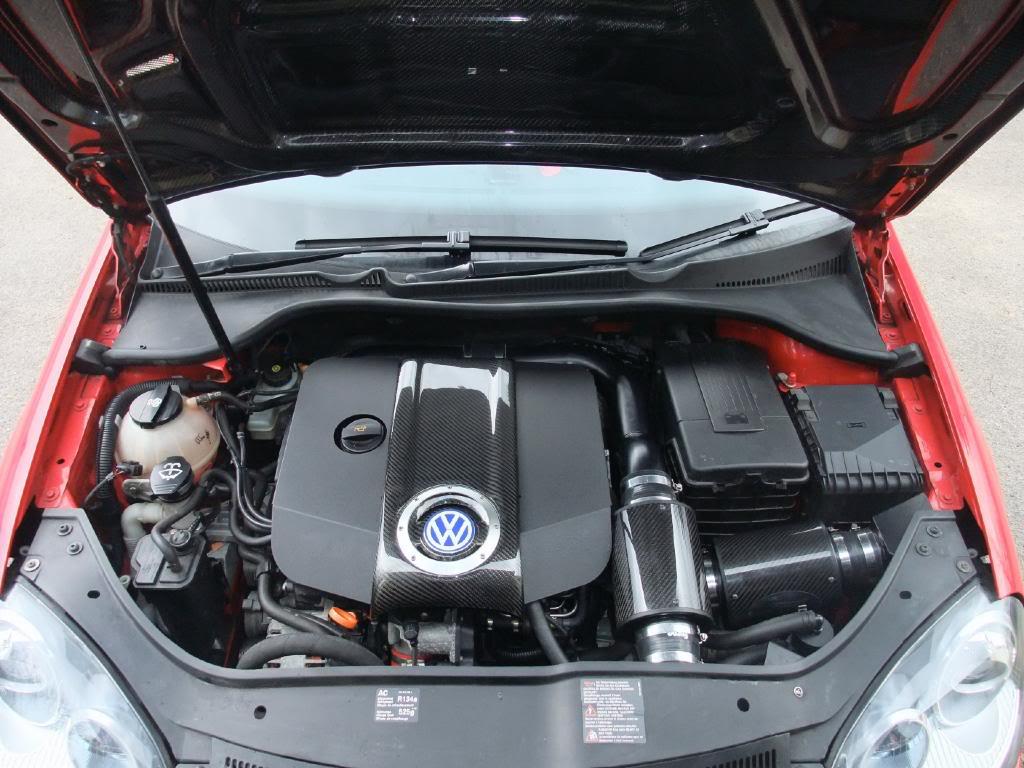 BREATHE IN!:
BREATHE IN!:Most aftermarket specialists agree that the Volkswagen boffins were right to position the stock inlet at the top of the front grill just under the bonnet's leading edge to ram air to the filter. Forge have placed their TWINtake's principal inlet in the same position. They are not the first to do this but they are the first to also position an additional inlet and second, twin filter in the side behind the headlight.
In development Forge conducted tests with both one and two filtered inlets and surprisingly, the addition of the second sealed inlet behind the headlight showed an increase in airflow and power over a single ram air design. Incidentally they plan to release a single filter version in due course.
TWO INLETS + TWO FILTERS:Most people on first setting eyes on the TWINtake (Forge's spelling) are very puzzled by there being not one but two filters. Does this work? But how can this possibly work efficiently? Is it just a gimmick? TWINcooler, TWINtake, are Forge now committed to only giving birth to twins? In my effort to understand this unusual intake I asked myself these questions and more. For those readers who are interested the answers are fairly lengthy:
Having twin filters is not a new idea on cars but Forge decided in early 2009 to investigate its potential for the 2.0T FSI engine (and now TSI version). As a relatively small English company with an established good reputation they would not have released it without spending an appropriate amount of time ensuring it worked flawlessly.
The main idea, though, is to create sealed inlets that allow for the introduction of the coolest ambient air possible. There are numerous debates among 'internet experts' but if the turbo system heats the air by say 50-70C before it hits the intercooler and the intercooler takes that back down by say 30-40C, then every degree colder your intake air then the lower your intake air temperatures are going to be post intercooler.
Cold air intake temp + Turbo increase temp - Intercooler reduction in temp = IA Temp in the manifold.
Apart from having the largest total possible surface area to the filtering media there are other benefits to a twin filter setup: Consider that a given filter size will present a given level of restriction to airflow, based primarily on the density of the filtering media. This will result in a given level of vacuum after the filter. Two identical filters, of the same level of restriction, applied to the same application as in this case, will apparently double the effective airflow possible by decreasing the restriction by roughly half. This will equate to more power potential.
The incorporation of a second filter doesn't introduce more airflow
volume. The 70mm piping, which Forge say is the max allowable for proper MAF calibration, will only flow a finite volume of air regardless of the number of filters used. Higher flowing air filters, however, provide for a reduction in effort required to draw air through them due to a decrease in flow restriction. A larger surface area through which airflow is introduced, provides for the least possible restriction in flow.
REDUCING RESTRICTIONS:I guess that if you've read this far, you're ok to read some more! Following the question of why bother to have twin fllters, the next question is what the heck happens when the two air flows meet and both enter the same pipe? Do we enter a wild whirlpool of turbulent air and spin out of control?
Even though all of the air is condensed into the single pipe, and any given vehicle is only going to demand so much air based on other modifications, tuning, load, etc., the faster the air gets into the engine, the better.
The filters themselves are the only components posing a restriction to the airflow. Imagine if you remove the filters entirely, there would be no restriction at all. But this isn't exactly safe for a daily driver. Adding more surface area to the filtering media, however, has a similar effect. There are more openings present that the air can flow through, so the demand placed on each is less, which effectively reduces the restriction and increases flow. You might draw the analogy that by having less draw from one filter, less air particles have to force their way through that filter, so it's like opening a new checkout in a grocery store.
 THE HOLY MAF:
THE HOLY MAF:The oem MAF housing incorporated into the stock intake/airbox assembly is actually ovoid in shape and is roughly equivalent to just under 70mm (inside diameter). The piping Forge use is 70mm (outside diameter). Once you factor in the wall thickness of the pipe, this is virtually identical to the stock MAF size. This is the same size piping Forge have been using in all of their 2.0T specific intakes for years now. I have specifically questioned Forge about this and am assured that there are no issues with MAF calibrations whatsoever.
 ALTERNATIVE INTAKES:
ALTERNATIVE INTAKES:- The simplest is an aftermarket panel filter in the stock engine cover box and an efficiently flowing ram intake such as a Carbonio.
- High-flow tubular air intakes with open filter cone and a cradle to help shield from engine bay heat. EVOMS, VF, BSH, are typical and prices from £150 to around £320. In JKM's experience on the K03 turbo, the EVOMS offers the greatest power increase of about 15 bhp on the K03 and closer to 20 bhp on the K04. They are somewhat unimpressed by the cheaper BSH.
- High-flow tubular but with cone filter fully enclosed and more expensive. Dbilas, GruppeM, and AWE are typical and APR are at early stages of development but are concerned that their costs and R&D may stop it coming to market.
- ITG Maxogen - This deserves particular mention because it is new and showing to be a high performer on the K04. At this time of writing it remains to be seen how it performs on the K03. Like the EVOMS, it is slightly more expensive than the TWINtake.
SteveP has written a review:-
http://www.mk5golfgti.co.uk/forum/index.php?topic=9698.0An excellent comparitive review by Zboyd:
http://www.seatcupra.net/forums/showthread.php?t=266452SOURCE:Direct from Forge Motorsport or their approved stockists. RRP £350.75 incl 15% vat and JKM offer a 10% discount for forum members, so £265+vat.
Visit their website or contact them for an up-to-date price : -
http://www.jkm.org.uk/performance/tfsiinduction.htmThe price may be a little steep for some but I know that Forge have done the best they can to minimise it without compromising the product. If you think that the carbon cannisters are the most costly component of the kit you'd be wrong - The mandrel bent aluminium piping is the most costly part. I think it worth pointing out that, unlike some other intakes, a heatshield is included in the price.
INSTALLATION: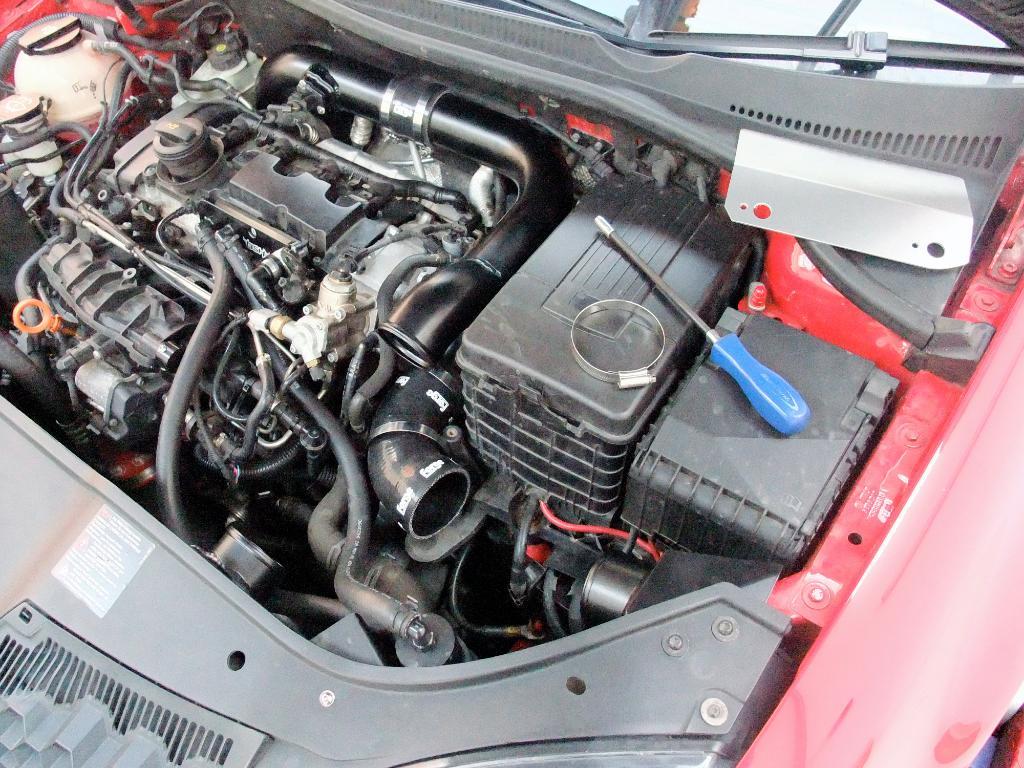
No fitting instructions were included with mine but there is a very comprehensive well illustrated step-by-step pdf online. It's a pity that increasingly manufacturers assume that everyone has online access wherever and whenever they want. Not printing instructions saves them money but the customer will have to print them.
As with everything I've seen Forge produce, the standard of manufacture is very high. It's the small touches such as supplying all the jubilee clips as stainless which reflect a pride in their work and are very satisfying for the customer. Installation is further made easier by both the orientation of the silver Forge stickers on the cannisters and a small arrow moulded on each end cap which indicates whether inlet or outlet - See under cutaway illustration of the filter and photos below. If you find displaying the two shiny silver labels too blingy for your taste it's very easily resolved: Either remove the stickers completely or, a better option if you ever want to sell it on in the future, simply fit the cans so the labels are hidden.


When fitted, the TWINtake is exceptionally well anchored and simply doesn't need any additional fixings along the length of its pipework. The two metal inlets are bolted down at the front and then it bridges along to being firmly attached at the turbo, so technically it's a free floating unit but a very rigid and strong one. The TWINtake is fitted independently of the engine except to the turbo so isn't adversely effected if you do have any engine movement (engine rocking is guaranteed with stock engine mounts).

^ Filter manufacturer's cutaway illustration to show correct orientation of filter.
Forge UK, contrary to Forge USA, initially advised the opposite orientation! To be fair, it is very ambiguous and, to date (early September 2010), tests have shown that reversed orientation is not detrimental to function nor performance in any way. Obviously the filtering ability remains unchanged and any changes to flow will be minimal, likely imperceptible. This is now Forge's official position.
I am expecting to hear from Forge soon about their position and advice regarding those of us, includes me, who have their filters the 'wrong' way around.

^ Note the arrow indicating air suction ^ (you can be forgiven for interpreting the opposite)

^ Note the arrow indicating air delivery ^ (you can be forgiven for interpreting the opposite)
PERFORMANCE:To increase performance is principally why most people buy an aftermarket intake.
Here are the first session plots comparing before and after the installation of the TWINtake,
BUT the filters were fitted the wrong way round - This was partly due to someone in ForgeUSA including an ambiguous photo in the installation pdf and partly because JKM followed the usual practice of the smaller end of a cone-shaped filter facing forward (suction end). This has now been corrected but I am including the graphs from both the rolling-road sessions we did. My car, a K03 GTI, stayed on JKM's Dyno-Dynamics rollers the whole time. The graph peaking at 238.3 bhp was with a Carbonio ram intake plus ITG panel filter and the 253.8 bhp was with the TWINtake fitted. Air to Fuel (AFR) plot was flat-lining in both cases as it should do. Revo2 was already set B7 / T5 / F9 for the Carbonio and later adjusted to F8 after the TWINtake runs.
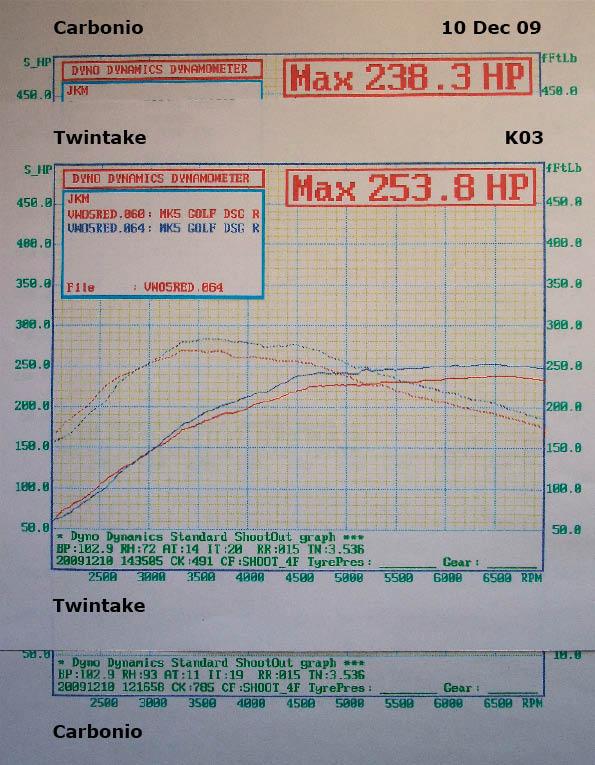
On my K03 GTI on the first dyno session day, we saw a healthy increase of 15.5 bhp. So, if the Carbonio adds say 4 bhp (some claim 7 bhp but who knows for certain?) to stock, then the TWINtake
theoretically delivers more neddies if compared with oem.
Accepting that any and every rolling-road 'test' of an air intake cannot reproduce what actually happens on the road we can only make relative comparisons. Consequently I decided to have another dyno session but continuing from the previous session by firstly running the TWINtake with its filters and velocity caps still the wrong way round and then directly comparing runs with the filters fitted correctly as designed. The incidental bonus from doing this was that we obtained data from the car in exactly the same state but on two separate days a week apart. Except that on the morning of the second session my car turned out to not be in exactly the same state because it had blown an O-ring and had a very minor boost leak. Ideally I needed to go for at least a 50-mile drive to get everything settled in after this was repaired but this wasn't practical. The resulting dyno curves were 'bumpy' as the ECU dynamically made whatever adjustments it felt were necessary on the fly. Such are the difficulties of closed loop systems as exist in the 2.0T FSI ECU. The highest bhp we saw plotted was 255 bhp but the whole curve reflected much variation.

So the conclusion at this stage is that the Forge TWINtake gains very similarly to the EVOMS when fitted to a K03 car, namely about +15 bhp. Logically, as the EVOMS has been seen to add about +20 bhp to a K04, one would expect the TWINtake to perform very similarly and hence matching the K04 performance of the ITG intake.
PERFORMANCE UPDATE:On the same rolling-road at JKM a couple of months later which obviously has given plenty of time for the ECU settle etc - A healthy further increase in power and especially torque. Nice curves as usual and testament to JKM choosing the right Revo settings:
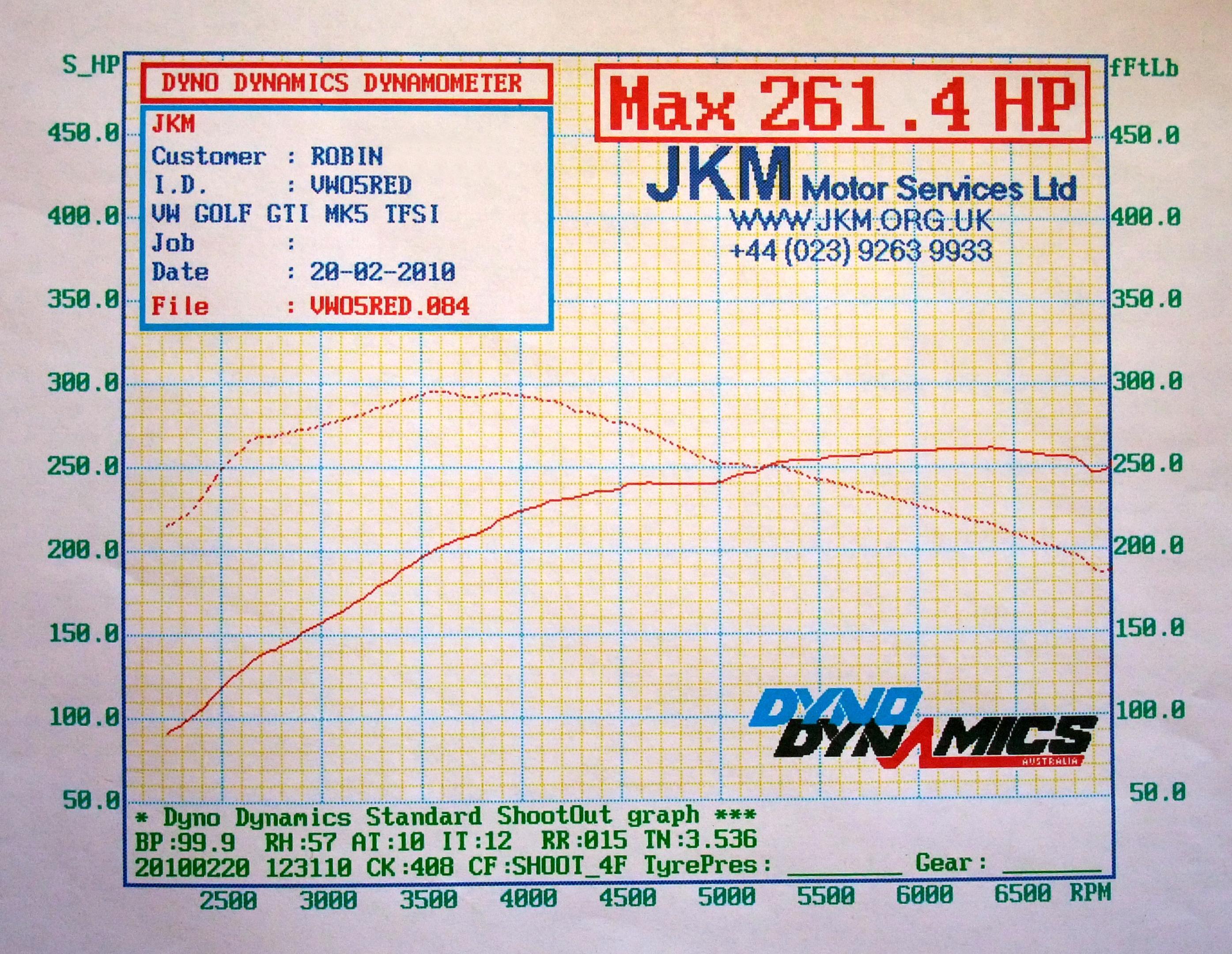
The latest (June 2011) dyno session at JKM - Everything has now settled in nicely:
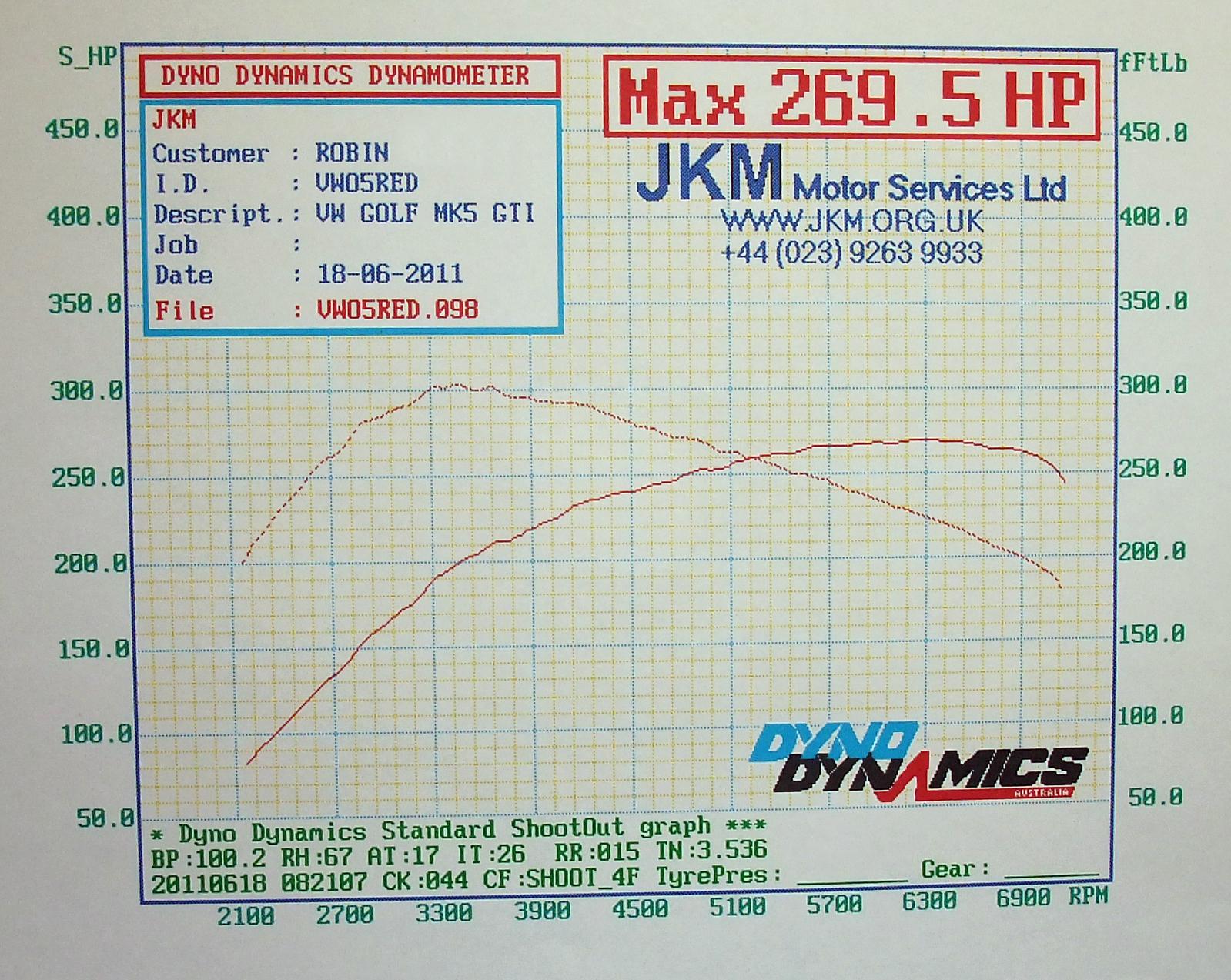
October 2012 dyno session at JKM:

The only other performance mod has been an APR High Pressure Fuel Pump. I am currently running on Revo Stage 2, B7 / T5 / F7.
SOUNDZ:A stock intake doesn't cause anyone to prick up their ears wondering what those fluttering and whooshing sounds are. I love all those sounds which give the driver the feedback of knowing when things are running as they should be. I hate soft ride caccoons (buy an average saloon car) - When modified the GTI can be both taut and tactile and a practical daily driver and remain the excellent allrounder it is renowned for. On the other hand, most Golf owners frown on excessive air dumping sounds which cause people on the pavements to think that a large bus with air brakes is about to flatten them. There is also a chav association which many Golf owners prefer to distance themselves from. It's interesting that in the U S of A the Golf GTI is inexpensive and bought by lots of youngsters who naturally quite like such exuberance, whereas the British generally tend to be far more reserved.
Sounds will vary according to the individual car. K03 or K04 turbo, aftermarket DV and where it's positioned, bonnet material and soundproofing if any, but I find the air breathing sounds very natural, even frighteningly human! Aftermarket engine mounts will of course transfer even more of the sounds I'm happy to say. I've also driven a K04 turbo'd Ed30 with front mounted DV and TWINtake and found it subtle and very enjoyable.
I haven't heard the ITG yet but I find the EVOMS too raucous and it might irritate me. The TWINtake is just as capable of making noise and does so according to how you use your right foot - Lift your foot suddenly and quickly and you'll hear the usual whipping sounds. Use your foot more progressively and you'll still hear induction sounds but more subtley.
EYE-CANDY:Oh so subjective! What some love, others hate. Some will say that people rarely see what's under the bonnet and so what it looks like simply doesn't matter one little bit. Even if you're a bloke, your underwear might be something which is rarely seen, but don't you care at all what it looks like? Whereas I agree that function shouldn't be sacrificed for the sake of form, my view as a hardwired design professional is that a successful integration of
both form and function is the ideal. And guess what - The TWINtake scores well on this integration in my opinion. Although at first I was taken aback by the unfamiliarity of seeing two filter cannisters, their carbonfibre finish quickly won me over.
PLUS POINTS:- Gains a respectable +15 bhp to a K03 car and so represents good value for money.
- Twin filters adding up to a very large total surface area.
- Sealed dry filters with velocity caps and very little maintenance.
- Mandrel bent aluminium piping in powdercoat finish.
- Proven to be MAF-friendly.
- A good quality heatshield is included and optimises the available area - Each supplied according to your engine code.
- Extremely well made with great attention to detail such as supplying jubilee clips as stainless.
- Solidly fixed and with good fitting instructions.
- Sophisticated sounds: Very audible but not overwhelming or 'chavvy'.
- Unusual but a high eye-candy factor, though such a judgement can be subjective, particularly if you don't like carbonfibre.
MINUS POINTS:None regarding the TWINtake itself that I can identify at this stage but I will add here if and when I find any*. However, I have to be honest and report that I wasn't impressed about a couple of things from ForgeUK. The first was that the wrong heatshield was supplied in spite of them knowing my build date and engine code. But, on receiving my phone call, Forge interrupted their production to manufacture the correct heatshield the same day and immediately shipped it UPS - That's excellent customer aftersales care. Also the MAF screw threads needed excess powdercoating cleaning out and you may not have appropriate tools if you are installing the TWINtake on your front drive at home. But it should be noted that none of these mistakes diminish what the TWINtake has to offer.
*- Since originally writing this review, there have been reports of "whistling" sounds which have been described as undesirable by those who have reported them. No evidence of such sounds on mine. Forge haven't received any such feedback from customers so far.
*- There have been reports of the Twintake not delivering enough power when combined with Stage 2
+ remaps on the K04 turbo'd cars. To be fair, I don't think that the Stage 2+ software was available when Forge were pre-release testing.
MAINTENANCE:Very minimal and very easy but an absolute pig to undo the Phillips screws attaching the end caps to the filter housings for the first time - They certainly are sealed! I'm advised by JKM to check the filters every 20k miles and they had a fine nozzled air gun which was able to clean them without undoing the end caps. Change plugs and check filters is an easy one to remember. The filters are dry.
THE KNOCK-ON EFFECT:As you increase the efficiency of your air intake you may reach a point where the AFR (Air to Fuel Ratio) causes running problems which the ECU then protects the engine from by applying fuel cuts. But whilst driving on the road midst an overtake, this doesn't protect
you!. The expensive solution is to have an aftermarket fuel pump and appropriate remap for it. The easier way is to reduce your Boost setting but this is probably only possible on Revo software which enables fine tuning Boost/Timing/Fuelling by either the user or agent - An extremely useful feature on any modified car. As it turned out, with JKM's expertise we were able to keep the Boost at 7 but reduced the Fuelling from 9 to 8.
But the above applies to a Stage 2 remapped car with other engine performance modifications. I know that Forge fitted a Twintake to a completely standard Leon Cupra without any subsequent problems or adjustments being needed.
SUMMARY:Forge wanted to combine a larger surface area of filtering media with the induction of the coolest possible ambient air. The oem frontal ram position just below the bonnet has been shown to be a prime position and also avoids hydrolock from water ingress. The side inlet duct of the TWINtake is pulling air from around the back of the headlight housing from the inner fender well behind the bumper and fender, where the filter of some other air intakes are placed. This is just a location from which to duct cooler ambient air rather than the warmer air from directly within the engine bay. Having sealed filters greatly helps maintain cool temperatures and, whether you like carbonfibre's appearance or not, it has beneficial properties in rejecting ambient heat.
I feel that the dyno runs which we were able to do were unfortunately slightly spoilt by the immediate aftermath of my minor boost leak but that they nevertheless demonstrate a very respectable +15 bhp gain and also some gain in torque.
The next dyno session I have at JKM should further confirm our findings and the whole performance curves should settle back down to the smoothness I am used to seeing. In driving there is a definite power gain which can be felt.
I still don't fully understand how that side inlet collects enough air to make the difference but whatever the physics and theories, it works - It really is that extra supermarket checkout which makes the difference to flow. Regarding buying it, the bottom line is does the TWINtake work well amongst your car's other modifications and does it meet your individual criteria? - My answer is "Most definitely!"
INEVITABLE COMPARISONS:Unfortunately the only meaningful way to make direct comparisons between the various intakes is to dyno and data log them fitted to only one car and on the same day as there can be so many variables.
ITG have released their Maxogen intake for the 2.0T FSI platform at more or less the same time as Forge have released their TWINtake. However, undoubtedly well as the ITG performs it is more expensive. So it's inevitable that some sort of comparisons will be made and that they will be primarily judged on their performance differences. (Notice that I haven't mentioned foam blocks.. yet!). Friendly competition between manufacturers is healthy - It benefits both the consumer and the developer.
Ultimately we buy what we do for a whole host of very different reasons and I'm not suggesting that the TWINtake is the only nor the best intake solution of all for every car. Hopefully I have provided enough information for you, the reader, to understand how the TWINtake works and its benefits and consequently for you to decide if its the one for you.

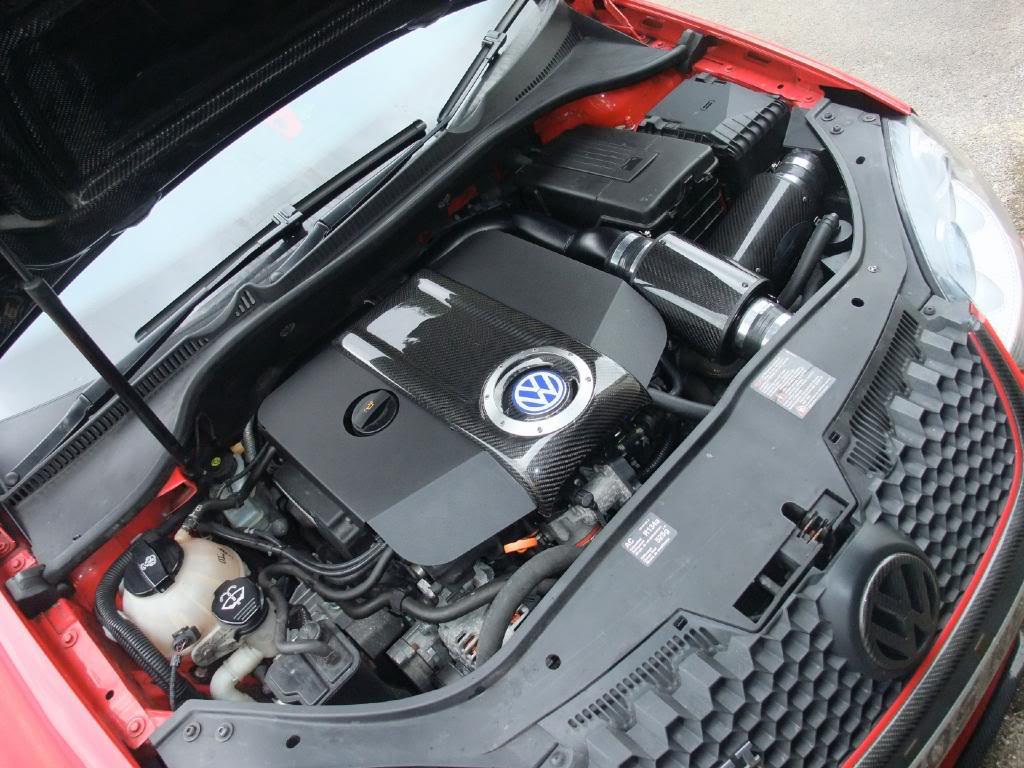
I would particularly like to thank Mike@ForgeUSA for information he has provided about how the TWINtake works.
UPDATE @ 100,000 MILES:Although we (JKM) were able to reduce the Boost setting by a notch on my Revo Stage 2 to compensate for the extra efficiency of the aftermarket Forge Twintake, at about 20,000 miles since fitting, the stock fuel pump sometimes momentarily struggles when pushing on hard. Fortunately it doesn't create any abrupt fuel cuts but I decided to get an APR High Pressure Fuel Pump to better handle requests and return the Revo2 Boost to what it should be.
This is something that anyone buying an efficient aftermarket air intake best be aware of.